 Duke Humfrey’s Library
Duke Humfrey’s LibraryIt was over a year ago that I became aware that the Bodleian Library in Oxford had recently acquired a manuscript pocket diary that was catalogued as:
‘Diary of Mrs Starke, relative of the playwright and travel writer, Mariana Starke, 1791. This Ladies Pocket Journal; or Toilet Assistant: For the Year 1791 had been published in London by S. Bladon and comprised 84 leaves in a binding of gilt-stamped roan, with flap, clasp missing, marbled endpapers. The catalogue description went on to explain that ‘From internal evidence it appears that the author was the wife of ‘Starke’, an officer in the army, and a relative of the playwright Mariana Starke. They were married 16 Feb. 1764 (see fol. 18v). There are brief entries each day describing her social engagements and her husband’s movements. They often visited Mariana Starke’s family at Epsom and were frequently in the audience at her new play, ‘The Widow of Malabar’. The entries include weekly accounts. Many are supplemented by notes in shorthand.’
I was intrigued. Having, as I thought, researched Mariana Starke’s family fairly comprehensively from her great-grandfather’s merchant life in the late 17th century, through the overseas adventures of her grandfather and father I was interested in discovering who this ‘new’ Starke relation was. For I could not place any ‘army’ Starke – married in 1764 – in the family tree. Nor, using all the wonderful internet genealogical sites that we now have at our disposal, could I discover a suitable 1764 Starke marriage. I was, however, quite prepared to believe that the marriage had taken place abroad – perhaps in India – or that there were collateral branches of the family of which I knew nothing. And it was certainly interesting to know of anyone who had had such close contact with Mariana – as this diarist apparently had
So, I eventually got round to planning a visit to Oxford and amassing the various forms that would allow me access to the Bodleian Special Collections. It was some years since I had been there – and then it had been to research the 19th-century suffrage movement. That had not necessitated sitting amidst the splendour of the Duke Humfrey Library; what a pleasure it was to do so now.
I devoted about four hours to reading this little diary. The shorthand was impenetrable, the conventional handwriting crisp and legible, but at the end of my visit I was no clearer as to the identity of the diarist than I was at the beginning. One thing was incontrovertible – she did refer to her husband as ‘Starke’ or ‘S’ throughout – and there was no mention of any other family name. There were, however, various clues as to identity – of which I took careful note. There was the date of her wedding – on 16 February 1791 she had been married 27 years and there was mention in March of the birth – abroad – of a third son to her own son. Further reading showed that her son’s name was William; there was no mention of any other children, so perhaps, I thought, William was her only son. It also appeared that William’s wife was ‘Lady Sarah’, a daughter of Lord Plymouth. Moreover after her son’s family returned from abroad they were all staying with the diarist when the new grandson was christened ‘Augustus James’, in July, from her house.
On my return home I used this information to search the online websites for a likely Augustus Starke, a William Starke, a Lady Sarah Starke – all to no avail. I then made a wider search – using just the names ‘Augustus James’ and a date of birth ‘1791’. And immediately came up with the answer to the conundrum.
 Champion Lodge, Camberwell, a watercolour painted in 1823 by which time Mrs Crespigny’s son, WIlliam, had inherited the estate. Courtesy of Surrey History Centre.
Champion Lodge, Camberwell, a watercolour painted in 1823 by which time Mrs Crespigny’s son, WIlliam, had inherited the estate. Courtesy of Surrey History Centre.The diarist’s family name is not ‘Starke’ but ‘Crespigny’. She is Mrs Mary Crespigny of Champion Lodge, Camberwell, patron and friend of Mariana Starke. Mary Clark (1748-1812) (see her portrait here) was married at St Giles, Camberwell, to Claude Champion Crespigny (1734-1818) on 16 February 1764 (see here for his portrait, painted 10 years before the marriage). Their only child – a son – William (1765-1829) was baptized at St Giles Camberwell (Jan 1765). William Crespigny married Lady Sarah Windsor, daughter of the Earl of Plymouth, in 1786. William Crespigny’s third son, Augustus James Crespigny, was born on 9 March 1791 in Nice and baptized at St Giles, Camberwell, in July 1791. The military group to which the diary often refers – her husband is on duty etc – is likely to have been the Camberwell Volunteers (which may have had a slightly different name in 1791), to whom Lady de Crespigny (Claude Crespigny was created a baronet in 1805) later presented colours.
I – and the Bodleian – would be most interested in hearing from anybody who might be able to shed light on why Mrs Crespigny referred to her husband – Claude Champion de Crespigny were all the names he seems to have possessed – as ‘Starke’. There is not, as far as I know, any connection between the families by either blood or marriage. There was, however, certainly a connection between Mary Crespigny and Mariana Starke – sympathy – and the theatre. Their preoccupation with drama – as writer, actor and patron – will become clear in a subsequent post. But for the time being let me mention that Mrs Crespingy noted on 12 January in this 1791 diary that:
‘Miss Starke’s play The Widow of Malabar came on and it went off extremely well – but Lady Salisbury took my Box which caused great confusion’. A week later, on Wednesday 19 January, Mrs Crespigny attended ‘Third night of the Widow. Miss Starke had a very full house. I sent [?] vast numbers – filled 10 rows of pit & nearly all the Boxes – & numbers [?] into the Gallery.
As I say, Mrs Crespigny’s handwriting is really very clear and these lacunae could have been filled in – or puzzled out – had more time been available.
With the identity of the diarist known, the names she mentions can begin to shape themselves into a circle of acquaintances – families that lived within riding distance of Camberwell or whom she saw on her frequent visits to Town. Epsom was a favourite haunt – not only to visit – or even stay with – the Starkes at Hylands House, but to go hunting (Mr Crespigny) or for archery (Mrs Crespigny). For Mary Crespigny, I now discover, was an early female toxophilite, the diary describing competitions held at Epsom and Box Hill. In fact, with the diary identified as recording a year in the life of Mrs Crespigny, it now has a considerably greater significance than if it had indeed belonged to a shadowy ‘Mrs Starke’. It only now requires a cryptographer to set to work to decode the sections that she wished to keep safe from prying eyes.
I shall certainly have to return to Duke Humfrey’s Library and re-engage with Mrs Crespigny’s diary. One piece of information that it contained pleased me greatly: she notes the exact day on which the Starkes embarked on their travels on the continent and, before the year’s end, records letters from Calais and Lyons. These letters were undoubtedly penned by Mariana who, despite the difference in their ages, was, the diary makes clear, Mrs Crespigny’s especial Starke friend.
Copyright
#1 by Anne on May 7, 2013 - 2:42 am
Thank you so much for this insight in to Mary, Lady de Crespigny née Clarke (1749 – 1812) . I have just started writing a family history blog and my entry on Mary is at http://ayfamilyhistory.blogspot.com.au/2013/05/a-toxophilite-mary-de-crespigny-nee.html . If I gain any insights as to why she used the name Starke in her diary I will let you know.
Regards
Anne
#2 by womanandhersphere on May 7, 2013 - 8:23 am
Good to make contact. Love all the ‘cuttings’ re Mrs de Crespigny.There was certainly mention of archery in the Bodleian diary – although, as I explain in my post about it, when I was reading it I had not then worked out who the author of the diary was. So archery references etc all made much more sense once I knew. It will be a must for you to read if you are ever in Oxford!
Best wishes
Elizabeth